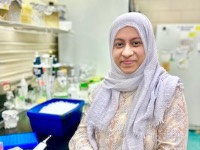Current Members
 Anne Grove
Anne Grove
Ouachita Parish Chapter Alumni Professor
We are focusing on how proteins bind to DNA to control cellular function, including processes such as gene expression and bacterial virulence.
One focus is on architectural proteins that control compaction of genomic DNA, including the eukaryotic High Mobility Group (HMGB) proteins. We are currently pursuing the role of the yeast HMGB protein Hmo1p in stabilizing chromatin and regulating gene expression in response to cellular stress.
We also focus on a group of bacterial transcriptional regulators designated MarR (for Multiple Antibiotic Resistance Regulator) and the mechanism by which the binding of ligand or the oxidation of cysteine controls their ability to regulate gene expression. A particular emphasis is on a subset of these transcriptional factors that bind the ligand urate and on the role of urate in signaling host colonization.
 Nabanita Bhattacharyya
Nabanita Bhattacharyya
Postdoctoral Researcher/Instructor
I just love Vibrios….and teaching BIOL 1001!
Publications:
Nwokocha, G. C.,* Bhattacharyya, N.,* LeBoeuf, E. N., Elkholy, H. and Grove, A. DNA distortion by the Burkholderia thailandensis transcriptional regulator FusR2 is abolished by fusaric acid binding. Biochemistry, 64, 4682-4691 (2025). *Equal contribution.
Bhattacharyya, N., Lemon, T. L. and Grove, A. A role for Vibrio vulnificus PecS during hypoxia. Sci. Rep. 9, 2797 (2019).
 Muneera Mashkoor
Muneera Mashkoor
Graduate Student
I like change and thus I am trying to change the sequence of binding site for some transcription factors in Saccharomyces cerevisiae using CRISPR/Cas9 genetic engineering tool.
Publications:
Kumar, S., Mashkoor, M., Balamurugan, P. and Grove, A. Yeast Crf1p is an activator with different roles in regulation of target genes. Yeast 41, 379-400 (2024).
Kumar, S., Mashkoor, M. and Grove, A. Yeast Crf1p: An activator in need is an activator indeed. Comp. Struct. Biotechnol. J. 20, 107-116 (2022).
Kumar, S., Mashkoor, M., Balamurugan, P. and Grove, A. Intricate regulation of ribosome biogenesis genes in response to mTORC1 signaling. bioRxiv. (2021).
 Elaine Nkwocha
Elaine Nkwocha
Graduate Student
enkwoc1@lsu.edu
Brave space with Elaine - mentoring
Biofilm formation plays a key role in the pathogenesis of chronic infections and redox homeostasis plays a role in biofilm morphology. In the species Burkholderia thailandensis, biofilm formation is a severe complication and makes bacteria resistant to host defenses and antibiotics. My research is focused on determining the mechanisms by which a redox sensitive biofilm regulator protein (BifR) impacts bacterial physiology and fitness. BifR is encoded as part of the emrB-bifR operon, where emrB encodes a predicted efflux pump, and the locus is conserved among the more pathogenic Burkholderia species.
 Ahmed Al-Tohamy
Ahmed Al-Tohamy
Graduate Student
My research interests lie within the realm of deciphering complex biological systems. Elucidating the mechanisms driving multifactorial phenotypes is especially enigmatic, as they often arise from the dynamic interplay between intrinsic genetic regulation and extrinsic environmental cues. I am particularly interested in how bacteria detect and respond to host-derived metabolic stress signals to rewire regulatory and metabolic networks that control survival, adaptation, and virulence.
A central focus of my work is urate, a purine degradation product produced by the host. In Burkholderia thailandensis, urate binds to the global regulator MftR, inducing conformational changes that alter its DNA-binding activity and trigger genome-wide transcriptional shifts. I use ChIP-seq to map MftR targets and build regulatory networks, alongside quantitative proteomics and untargeted metabolomics to track changes in protein expression and metabolism under stress. I also investigate efflux pumps, key bacterial systems for resisting environmental and host-derived stress. In addition, I study purine riboswitches, structured non-coding RNAs that sense metabolites, and I develop AI-driven models to identify and classify these regulators across bacterial genomes. My long-term goal is to target global regulators like MftR to disrupt bacterial sensing of host-derived signals such as urate, providing a novel route to disarm virulence and combat antibiotic resistance.
Publications:
Al-Tohamy, A., Donnarumma, F. and Grove, A. Transcriptome-proteome profiling in Burkholderia thailandensis during the transition from exponential to stationary phase. J. Proteome Res. 24, 4082-4097 (2025).
Al-Tohamy, A. and Grove, A. Targeting Bacterial Transcription Factors for Infection Control: Opportunities and Challenges. Transcription 16, 141-168 (2025).
Thapa, S. S., Al-Tohamy, A., Grove, A. The global regulator MftR controls virulence and siderophore production in Burkholderia thailandensis. J. Bacteriol. 204, e0023722 (2022).
 Erin LeBoeuf
Erin LeBoeuf
Graduate Student
The title of my Dissertation? Urate-responsive transcription factors and where to find them.....
Publications:
Nwokocha, G. C.,* Bhattacharyya, N.,* LeBoeuf, E. N., Elkholy, H. and Grove, A. DNA distortion by the Burkholderia thailandensis transcriptional regulator FusR2 is abolished by fusaric acid binding. Biochemistry, in press. *Equal contribution.
LeBoeuf, E. N. and Grove, A. CysB in the Multiverse of Functions: Regulatory Roles in Cysteine Biosynthesis and Beyond. Front. Biosci. (Landmark Ed.) 30, 36563 (2025).

Sarmin Akter
Graduate Student
My research aim is to reveal the regulatory roles of a MarR (Multiple Antibiotic Resistance Regulator) transcription factor in the gene expression of an efflux pump in Burkholderia thailandensis.

Yasodha Gamage
Graduate Student
I am very curious basically about the gene expression in Burkholderia thailandensis under anaerobic conditions, when given different treatments...
Md. Saiful Islam
Graduate Student
Jayden Bates
Undergraduate Student